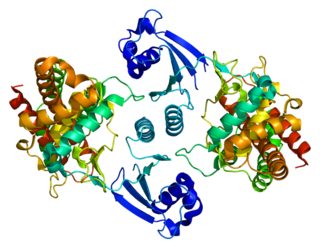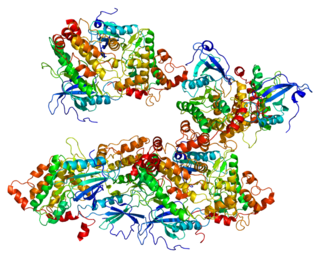
The CpG sites or CG sites are regions of DNA where a cytosine nucleotide is followed by a guanine nucleotide in the linear sequence of bases along its 5' → 3' direction. CpG sites occur with high frequency in genomic regions called CpG islands.

E3 ubiquitin-protein ligase CHFR is an enzyme that in humans is encoded by the CHFR gene.

Septin 2, also known as SEPT2, is a protein which in humans is encoded by the SEPT2 gene.

Hsc70-interacting protein also known as suppression of tumorigenicity 13 (ST13) is a protein that in humans is encoded by the ST13 gene.

Septin-5 is a protein that in humans is encoded by the SEPT5 gene.

Septin-4 is a protein that in humans is encoded by the SEPT4 gene.

Choline kinase alpha is an enzyme that in humans is encoded by the CHKA gene.

Septin-6 is a protein that in humans is encoded by the SEPT6 gene.

Folylpolyglutamate synthase, mitochondrial is an enzyme that in humans is encoded by the FPGS gene.

Septin-7 is a protein that in humans is encoded by the SEPT7 gene.

60S ribosomal protein L35a is a protein that in humans is encoded by the RPL35A gene.

Zinc finger protein OZF is a protein that in humans is encoded by the ZNF146 gene.

Aldo-keto reductase family 1 member B10 is an enzyme that in humans is encoded by the AKR1B10 gene.

Regenerating islet-derived protein 4 is a protein that in humans is encoded by the REG4 gene.

Death-associated protein kinase 2 is an enzyme that in humans is encoded by the DAPK2 gene.

DNA repair and recombination protein RAD54B is a protein that in humans is encoded by the RAD54B gene.

Septin-11 is a protein that in humans is encoded by the SEPT11 gene.

Myeloid/lymphoid or mixed-lineage leukemia 4, also known as MLL4, is a human gene.

ASH1L is a histone-lysine N-methyltransferase enzyme encoded by the ASH1L gene located at chromosomal band 1q22. ASH1L is the human homolog of Drosophila Ash1.

Zinc finger FYVE domain-containing protein 19 is a protein that in humans is encoded by the ZFYVE19 gene.




















